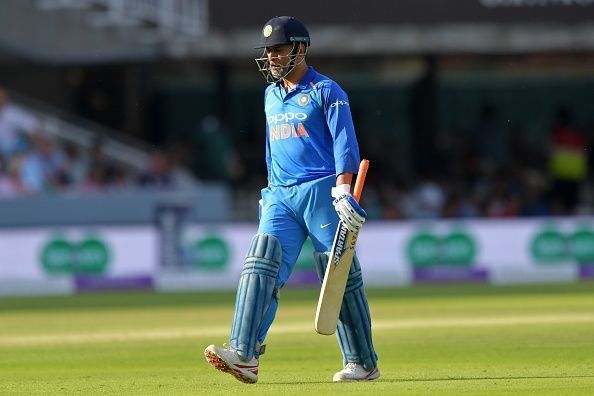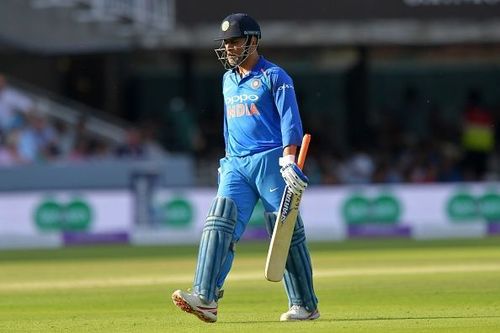
MS Dhoni is not at fault, we are

December 30, 2012. The left-arm seam bowling duo of the incisive Junaid Khan and the imposing freak that is Mohammad Irfan, run through the Indian top-order. All of a sudden Chepauk turns into Centurion, as the hosts are befuddled by the nip off the pitch and the parabolas in the trajectory of the deliveries under the grey skies.
Three batsmen suffer the ignominy of having to hear the ominous sound of the stumps' rattling, as the scorecard reads 5/29 in 9.4 overs.
Out walks MS Dhoni, a calm demeanor on his face almost antithetical to Rohit Sharma's look of disbelief and complete lack of belonging as he walked back. Except that the calm will not precede a storm; it will remain steady throughout, and with the passage of time inch closer and closer to nirvana.
The keyboard warriors, a generation of impatient kids with their attention spans reduced to Curtly Ambrose's batting average, or the bowling average of John Wisden in case you are one for constructive criticism, cry out in unison for a counterattack to battle the heat of the Pakistani pace battery.
Dhoni knows better than that. He always has.
Between the pride of batsmen to not take the unconventional route and the prejudice of menacing fast bowlers bowling banana balls whilst shrugging with indifference, it is solely the sense and sensibility of Dhoni to bring out his dogged side.
40 overs later, he is walking back to the pavilion, unscathed and unbeaten on 113 off 125, having played arguably one of the best knocks by an Indian in the format.
Six years have passed since then. Dhoni has seen the world of cricket turn on its head, and England have gone on to become the powerhouse of limited overs cricket - after five decades of being clueless about the dynamics of the play.
Their rise has been catalyzed by the nature of the pitches at home, more expressways than strips of earth, which don't have the slightest potential to ask questions of the batsmen. It has gotten to a point where the English lower order received some flak for not being able to maintain a run rate of 10 towards the end of the 50 overs.
Has Dhoni, India's quintessential one-day cricket messiah, been able to keep pace with the revolutionary transition?
Skip to July 14, 2018. Dhoni walks in at Lord's with the score 4/140, a far cry from the helplessness he walked out to at Chepauk. Chasing 322, he decides to play himself in, assess the wicket and then deal the finishing blows.
Has this not always been the plan? Has this not always been the effective approach lauded in the hours of triumph?
But it does not come off the way he would have liked to. Troubled by the sight and presence of a struggling Suresh Raina at the crease followed by the lack of reliability in Hardik Pandya, Dhoni does not have the luxury of being the lone man in charge this time around. By the time Pandya falls, the required run rate has soared to two runs per ball, with 66 deliveries to go, and none but sub-optimal tail-enders for company.
The constraints of the situation are sufficient to suffocate even Dhoni. Despite 504 international appearances to his name, he is not able to deal with the dilemma on hand. It is a choice between a conservative approach in the light of thinned batting resources and an all-out attacking approach that made sense considering the runs required, but which would have given the impression of rash and unintelligent cricket.
Time passes by quickly while the thought process is still going on in Dhoni's head. The outcome would have resulted in no-holds barred criticism of India's most scrutinized cricketer since Sachin Tendulkar, irrespective of which methodology he decided to go with.
As the required run rate shoots up to 27, Dhoni, pulls Liam Plunkett in vain; his effort at dispatching the short ball is more a desperate cry to tend to the growing restlessness of the spectators than an effort of sincerity. Unsurprisingly, the ball is sent down the throat of Ben Stokes patrolling the boundary.
Dhoni is booed off the field.
In the next match, similar circumstances do not allow him to get going, and he has to settle for safety over glitz - resulting in an under-par first innings total for India. In an innings where the premium opener scores 2 off 18 balls, the most assertive man on the field fails to communicate effectively and gives away his wicket in a suicidal run-out, the widely proclaimed best batsman in the line-up makes an ordinary leg-break delivery look like it was a Shane Warne jaffa, who cops the blame?
The senior-most player in the side, who is batting too low for his evolved attributes, running out of efficient batting partners and yet managing the innings' third highest score to take the side to a total that would give them a chance to put up a fight in the second half of the game.
Once again, MS Dhoni is booed for playing one mistimed stroke at 42.
In a decade and a half of intensely played international cricket, no defeat, no send-off, no tantalizing vulnerability just short of the line would have hurt him as much as the public's vocal disapproval of his doggedness.
The same doggedness that gave India respectability all those years back at the Chepauk. The same will to fight that made him valiantly take blows on his body during the Oval Test in 2014 on a treacherous pitch under skies grayer than the strands of tiring wisdom he now carries on his face. As the batsmen around him faltered, he remained the only one with the courage to be unorthodox, to get his gloves filthy just to get the job done.
That very same stubbornness is now being questioned.
Just like many greats before him, Dhoni's never-say-die attitude in the face of insurmountable disaster will be cherished only after he leaves a void in Indian cricket. When failed run chases will throw an instant flashback to the Celkon Cup in 2013, where he smashed Shaminda Eranga into oblivion at Port of Spain to ensure a one-wicket victory for India. When bowlers will force the captain of the side to make a mockery out of the Decision Review System, when excitability and flaring tempers will hinder a team playing purely on instinctive reactions.
But until then, we can take one of the country's greatest representatives in the game, and subject him to treatment reserved for blameless scapegoats. We can place ourselves on pedestals higher than the man who, with the most humble smile and quietest serenity, wielded his gloves that might as well have belonged to Midas himself.
We have forgotten where to draw the line between a sportsperson attempting to execute his skills worth a lifetime of dedication to safeguard the interests of his side, and a person whose solitary obligation is to accede to what the masses demand of him. This, despite the fact that we know how the masses lack the understanding of the intrinsic nuances of one of the most complex sports in existence, how they slowly turn any athlete's hologram into that of exclusively an entertainer.
For what it is worth, we have to acknowledge that we have failed MS Dhoni as admirers of the game of cricket.